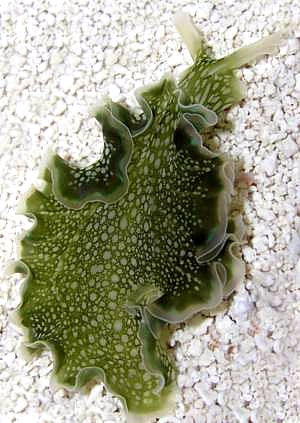
Elysia clarki
Pierce, Curtis, Massey, Bass, Karl & Finney, 2006
Order: SACOGLOSSA
Superfamily: ELYSIOIDEA
Family: Elysiidae
DISTRIBUTION
Commonly found in mangrove swamps, some borrow pits and mooring canals on the Florida Bay side of Long Key, Grassy Key, Crawl Key, Fat Deer Key and Vaca Key, Florida Keys, USA, in depths of 0 – 2.5 m.
PHOTO
Upper: Long Key, (Florida Keys, East coast), Florida, USA. Depth: 5 feet. in Mangrove Canal. Length: Approximately 45 mm in length. 2 June 2005. Photographer: Anne DuPont. Lower photos: Copied with permission from Pierce et al, 2006 to show midline gap between right and left parapodia [left] and colour pattern on sole of foot [right]..
Large elysiid, up to 45 mm long and 30 mm wide with prominent parapodia which are very folded at the edge. The parapodia on each side, almost meet in the dorsal midline, just in front pf the pericardial hump, but there is always a small gap, unlike E. crispata in which the parapodia fuse anteriorly. The body and parapodia are green with many large translucent white circular and ovate spots, which reduce the green areas to a reticulate pattern. The green is caused by the presence of intracellular algal chloroplasts located in cells at terminal ends of the finely branched digestive gland. The translucent white spots have many white and scarce turquoise iridescent pigment cells. This colour pattern occurs over the whole body, including the sole of the foot. The actual edge of the parapodia is translucent clear, and can have three colour bands, a continuous or broken orange band, a continuous green-turquoise band, and a continuous grey-green band -.but any of these can be absent or very reduced in any specimen.
Both E. crispata and E. clarki retain living chloroplasts which continue to photosynthesise within the body of the sea slug, providing it with sugars for its own nutrition. See the page on Solar powered sea slugs for further information. The process of taking chloroplasts from algal cells and keeping them has been given the name kleptoplasty
E. clarki has lecithotrophic larval development [non-feeding planktonic larvae] with veliger larvae metamorphosing into juvenile slugs after about 5 days. Extensive feeding experiments (Curtis et al. 2004) have found the juveniles will eat Bryopsis plumosa and Derbesia tenuissima [but not Caulerpa verticillata as reported by Jensen (1980)]. The length of the life cycle is unknown, but Pierce's lab have raised E. clarki from eggs in the laboratory that are still alive after 22 months and have not yet reproduced.
Molecular and microscopic evidence indicates that adult E. clarki feeds on and sequesters chloroplasts from Penicillus capitatus, P. lamourouxii, Halimeda incrassata and H. monile in the field and will survive for as long as two years in the laboratory on Bryopsis plumosa (Curtis et al. in press).
This species has been confused with Elysia crispata for many years. See separate message [#16728] comparing the two species.
-
Curtis, N. E., Massey, S. E., Schwartz, J. A., Tagihof, H. & Pierce, S. K. (2004) The intracellular, functional chloroplasts in adult Elysia crispata come from several algal species, and are different from those in juvenile slugs. Integrative and Comparative Biology, 44: 686.
-
Jensen, K. (1980) A review of sacoglossan diets, with comparative notes on radular and buccal anatomy. Malacological Review, 13: 55-77.
-
Pierce, S.K., Curtis, N.E., Massey, S.E., Bass, A.L., Karl, S.A. & Finney, C.M. (2006) A morphological and molecular comparison between Elysia crispata and a new species of kleptoplastic sacoglossan sea slug (Gastropoda: Opisthobranchia) from the Florida Keys, USA. Molluscan Research, 26(1): 23-38
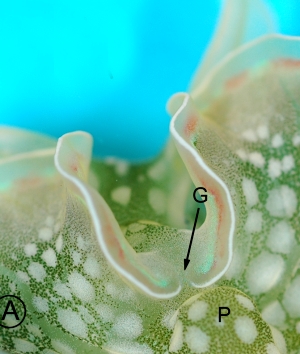
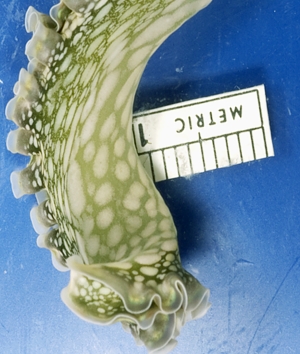
Rudman, W.B., 2006 (May 30) Elysia clarki Pierce, Curtis, Massey, Bass, Karl & Finney, 2006. [In] Sea Slug Forum. Australian Museum, Sydney. Available from http://www.seaslugforum.net/find/elysclar
Related messages
Relationship of Elysia diomedea and E. crispata
October 6, 2008
From: Patrick Krug
Concerning message #21911:
Hi Bill,
In response to your question about common ancestors in Elysia, my lab is working on a molecular phylogeny of the Elysiidae - a "family tree" based on DNA sequences. I have discussed the E. crispata / E. clarki issue with Skip Pierce at length, but my work in this area is unpublished so I don't want to say much for right now.
One of my students did a population genetic study of E. crispata from across the Caribbean; it's one of a dozen species we are studying to see if the period of time larvae spend in the plankton determines how much gene flow occurs between localities. E. crispata has little potential for larval dispersal, and not surprisingly we found deep genetic separation between at least six regional populations. Each population is 6-8% different from the others at the commonly used COI gene, suggesting hundreds of thousands of years of isolation. Within populations, we cannot distinguish E. crispata and E. clarki type slugs genetically. I think they might be ecotypes arising through parallel evolution in each regional population, but much more work remains to be done to sort this out (and it's equally interesting either way).
In comparison, E. diomedea and E. crispata/clarki are about 15% different from each other at the COI gene, a typical value for sister species of Elysia. Put another way, E. diomedea is equally distant from Florida E. clarki - type and Bahamas E. crispata - type slugs.
Hope that helps (at least a little),
Pat
pkrug@calstatela.edu
Krug, P. J., 2008 (Oct 6) Relationship of Elysia diomedea and E. crispata. [Message in] Sea Slug Forum. Australian Museum, Sydney. Available from http://www.seaslugforum.net/find/21944Dear Pat,
Thanks for your response. I wasn't really trying to reopen the E. clarki - E. crispata debate, I was curious to know if any work had been done on E. diomedea. But as you have brought up the E. clarki question again I can't resist a few thoughts - although I think we talked about this in Bonn.
As I am sure you are aware my background as a morphologist makes me very wary of dismissing the major morphological differences between E. clarki and E. crispata as being caused by environmental differences. If they are the same species, do you mean the two 'ecotypes' are the result of some embryological interaction with the environment during each individuals development? Or do parents produce both 'morphs' in their egg masses and only one morph survives? Or is there no gene flow between E. clarki environments and E. crispata environments and some form of genetic drift has occurred?
Your scenario of the same ecotypes evolving independently throughout the Caribbean doesn't seem to be to be the most parsimonious explanation - are there other examples of this? And if parallel evolution is occuring shouldn't the result of each parallel event be considered a distinct taxon? I'm afraid saying that even though there are morphological differences they must be ecotypes because the COI gene is the same in each 'type' seems a bit circular to me. Perhaps the COI gene is not the best indicator in this group?
Best wishes,
Bill Rudman
Elysia clarki feeding practices
December 6, 2007
From: Adam D'Agosto
I am totally fascinated by this creature and others like it and thankful for this forum, it is an amazing source of valuable information.
Thank you.
I have a question about the feeding practices of the Elysia clarki.
Does this animal only "feed" by photosynthesis? More specifically, can the E. clarki ingest "food" and use it to sustain itself via other means or mechanisms that does NOT depend on photosynthesis?
Essentially, I am trying to better understand this animal's needs and characteristics before attempting to keep one. From what I have read, it seems as though the E. clarki will "eat" in spurts. I use quotes around words to draw specific attention to them because this animal seems to be doing a lot more behind the scenes than most animals do. It "ingests" food, but later on it will "feed" on it.
Ultimately, I'd like to ascertain what a particular E. clarki is doing at a local aquarium store. The owner said he didn't want to sell him because he stopped eating. The same store also calls it a Lettuce nudibranchs. They also say it ONLY eats hair algae, so reliable information is hard to come by.
It seems to me this particular animal is in fact doing exactly what it's supposed to do; it's not eating hair algae, and it is reasonably active in spite of the fact that it's not "eating". This particular guy is about 2-2 ½" long.
Adam D'Agosto
adam@newair.us
D'Agosto, A., 2007 (Dec 6) Elysia clarki feeding practices. [Message in] Sea Slug Forum. Australian Museum, Sydney. Available from http://www.seaslugforum.net/find/21251Dear Adam,
Have a look at the species Fact Sheet and at earlier messages attached at the bottom of thr Fact Sheet, especially message #19329 which discusses what juveniles eat. Also some of the earliest messages on this species (when it was still confused with Elysia crispata) are accounts of people growing 'babies' in their aquaria.
Not all the information on a species is in the Fact Sheet so it is essential to look at the attached messages where new observations - often new to science - are recorded. I would say that Elysia clarki - one of the newest species of Elysia - is one of very few species for which we have good feeding information.
Best wishes,
Bill Rudman
Elysia clarki and E. crispata in Florida
October 10, 2007
From: Skip Pierce
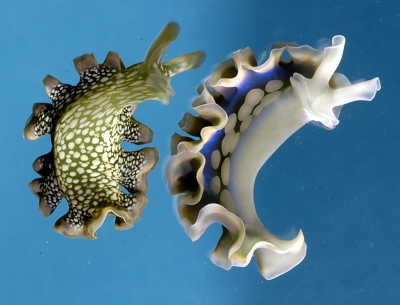
Hi Bill
Attached are a couple of comparative photos you may be interested in (taken by my post doc Nick Curtis and our colleague Ray Martinez) that provide a further comparison of Elysia clarki and Elysia crispata, this time both from Florida. Recently, we've had the opportunity to sample populations that are geographically very close to each other, probably 2-3 miles apart as the crow flies (or fish swims). The E. clarki came from mangrove swamps on the Keys and the E. crispata came from the offshore reefs of the Florida Keys National Marine Sanctuary at Looe Key- (all specimens were collected with permits from the State of Florida or from NOAA). Of course, the habitat differences between the swamps and reefs are large with respect to physical, chemical and biological properties.
Locality: Florida Keys, USA, Atlantic Ocean/Florida Bay, Oct. 2007. Length: 15-20 mm. Upper photo: Left: E. clarki, showing green aggregations of chloroplast on sole of foot. Right: E. crispata showing lack of green chloroplasts on sole of foot. Middle photos: Left: E. crispata showing anterior end of parapodia fused. Right: E. clarki showing gap between anterior end of parapodia. Lower photo: E. crispata showing aggregations of green chloroplasts on head foot and parapodia. Photos: Nick Curtis and Ray Martinez.
As you may remember, the E. crispata specimens we used in our paper describing E. clarki, came from the Virgin Islands, pretty far away from Florida. But the E. crispata in these photos are identical in morphology to those from the Virgin Islands (including the opaque foot and fused parapodia), and as you can see, quite different from E. clarki, as we described. We are going to do some DNA comparisons with these Florida E. crispata and E. clarki (and the DNA data we developed from the E. clarki that Colin Redfern sent us from Abaco). That will also tell us whose chloroplasts are present in the Looe Key specimens. However it'll take us several weeks to do those experiments. By the way, the bright blue color of the E. crispata in this photo, is not always present (but also occurs in some of the Virgin Island E. crispata, as we reported) - possibly from something they've eaten, but maybe not. We have never seen that blue in 1000's of E. clarki.
Skip
pierce@cas.usf.edu
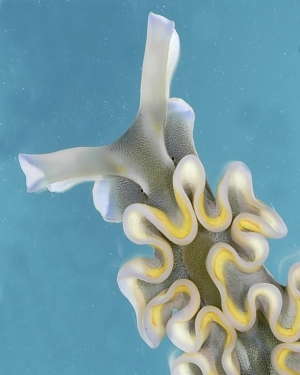
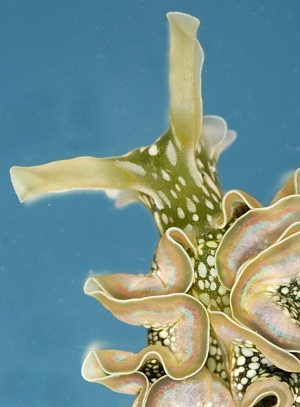
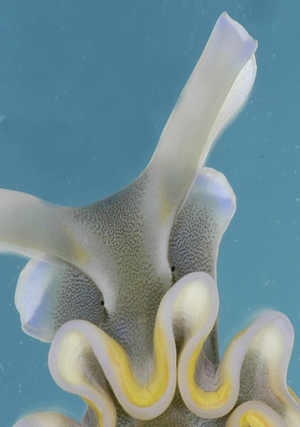
Dear Skip,
Thanks for these great photos. I wonder how anyone ever thought these two were one species. If the fused parapodia in E. crispata and the ramifications of the digestive gland into the foot of E. clarki can be dismissed as just 'ecovariations' it would undermine our use of morphological difference as the principal indicator of phylogenetic difference.
I have included a close-up of the head of E. crispata alongside as it shows the fused anterior parapodia very well and also shows the aggregations of chloroplasts [green specks ] which they have obtained from their algal food.
Best wishes,
Bill Rudman
Re: Elysia crispata in Cozumel, Mexico
February 2, 2007
From: Skip Pierce
Concerning message #19367:
Actually, this is a very good photo. No doubt from this view that this is an E. clarki. Also interesting (to us at least) is that, along with the photos provided by Colin Redfern, we now know that its distribution is at least to the northern Bahamas and also west across the Gulf of Mexico.
Skip
pierce@cas.usf.edu
Pierce, S. K., 2007 (Feb 2) Re: Elysia crispata in Cozumel, Mexico. [Message in] Sea Slug Forum. Australian Museum, Sydney. Available from http://www.seaslugforum.net/find/19376Re: Elysia crispata in Cozumel, Mexico
February 2, 2007
From: Jim Lyle
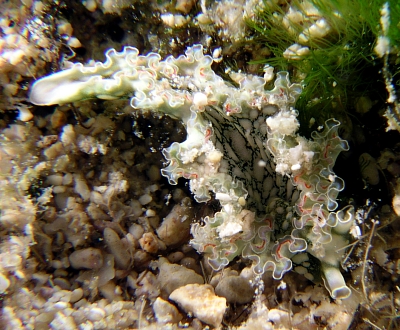
Concerning message #19367:
Dr. Rudman,
Here's another image of Elysia from Cozumel, Mexico.
Locality: Cozumel, 6 metres, Quitana Roo, Mexico, Caribbean, 11 August 2006, rock. Length: 10 mm. Photographer: Jim Lyle.
Jim Lyle.
jlyle@adelphia.net
Lyle, J.L., 2007 (Feb 2) Re: Elysia crispata in Cozumel, Mexico. [Message in] Sea Slug Forum. Australian Museum, Sydney. Available from http://www.seaslugforum.net/find/19377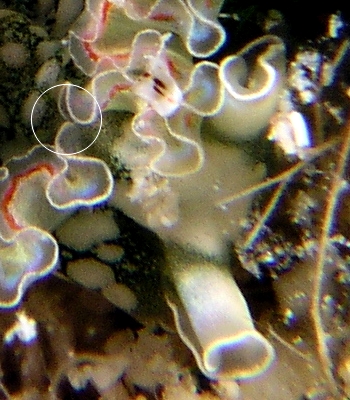
Thanks Jim,
I guess this illustrates the difficulty of working just with photos. I have put a ring around what could be a gap - but it doesn't seem to be in the midline - so it could be a fold . What it does do is publicise the value, if possible, of doing a quick little field examination of these 'frilly' Elysia species. If the parapodia are split at the front and / or there are green patches showing through on the sole of the foot then you have E. clarki, and if the parapodia are fused at the front and the sole of the foot is translucent white with no green patching then you have E. crispata.
Best wishes,
Bill Rudman
Re: Elysia crispata in Cozumel, Mexico
February 2, 2007
From: Sean Kearney
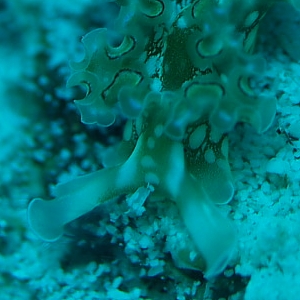
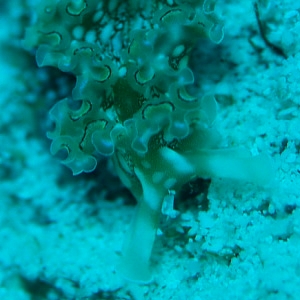
Concerning message #19359:
Dear Bill,
Sorry that I don't have any conclusive photos to confirm Skip's opinion. Perhaps the following two photos without strobe can help.
The current didn't allow much time for the close-ups or angles that I would like to have taken. Maybe next time.
Locality: Cozumel, Mexico, Caribbean
Thanks again,
Sean
skearney@dc.rr.com
Kearney, S., 2007 (Feb 2) Re: Elysia crispata in Cozumel, Mexico. [Message in] Sea Slug Forum. Australian Museum, Sydney. Available from http://www.seaslugforum.net/find/19367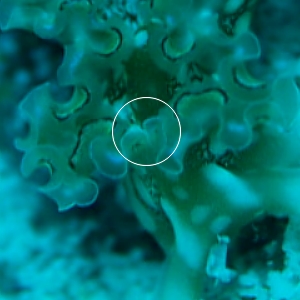
Dear Sean,
Thanks for the quick response. In the close-up alongside there certainly seems to be a gap separating the parapodia, rather than an overlap, which would tip the scales towards Elysia clarki. The other point Skip mentioned, which is not so easy to quantify, is that in E. clarki, the anterior limit of the parapodia is much further back than in E. crispata so specimens of E. clarki have a definite 'neck' [see message #16728]. So I would agree with Skip that this is most probably E. clarki. No need to apologise for not having the perfect shot. As you say it is the perfect excuse for another visit to Cozumel.
Best wishes,
Bill Rudman
Re: Elysia crispata in Cozumel, Mexico
February 1, 2007
From: Skip Pierce
Concerning message #19313:
Hi Bill
While it is tough to tell from this photo, I think this may be an Elysia clarki. I think the parapodia are not fused at the anterior. In moderate (such as this) to large E. clarki, the parapodia overlap at the anterior and if you look closely, it appears that it may be so here. Also, the tapered posterior end and the obvious head and neck are 'clarki-esque'. You are more skilled than I at intrepreting anatomy from digital photos, though, so take another look and see what you think.
Skip
pierce@cas.usf.edu
Pierce, S. K., 2007 (Feb 1) Re: Elysia crispata in Cozumel, Mexico. [Message in] Sea Slug Forum. Australian Museum, Sydney. Available from http://www.seaslugforum.net/find/19359Dear Skip,
I may be more skilled at looking at photos, but you are definitely more skilled at spotting E. clarki. The lower photo I posted was the highest resolution Sean sent so I wasn't sure if the whitish line in the photo, across the parapodia, in the anterior midline, was a wrinkle or an overlap. Hopefully Sean may have another photo, or a higher resolution scan which will show the detail more clearly
Best wishes,
Bill Rudman
Elysia crispata in Cozumel, Mexico
January 29, 2007
From: Sean Kearney
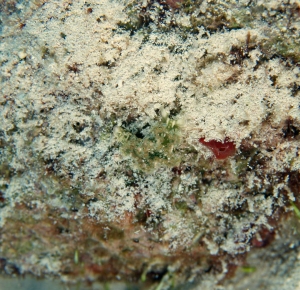
Note added 2 February 2007: This is most probably E. clarki [see message #19367].
Dear Bill...
I thought that I would add this pic of Elysia crispata for the forum as I couldn't find a record for Cozumel, Mexico. Found this on our last dive last week.
Locality: Cozumel, 40ft, Mexico, Caribbean, 20 Jan 2007, sandy reef. Length: 1 in.. Photographer: S. Kearney.
Thanks,
Sean.
skearney@dc.rr.com
Kearney, S., 2007 (Jan 29) Elysia crispata in Cozumel, Mexico. [Message in] Sea Slug Forum. Australian Museum, Sydney. Available from http://www.seaslugforum.net/find/19313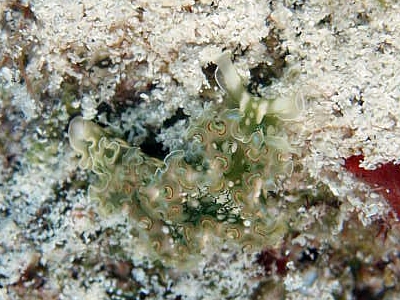
Dear Sean,
I am surprised that you saw it - it seems quite transparent, and so very well camouflaged - in your photo.
There doesn't seem to be any sign of a gap between the parapodia at the anterior end, so I guess this is indeed E. crispata and not E. clarki.
Best wishes,
Bill Rudman
Elysia clarki feeding references
January 29, 2007
From: Nicholas Curtis
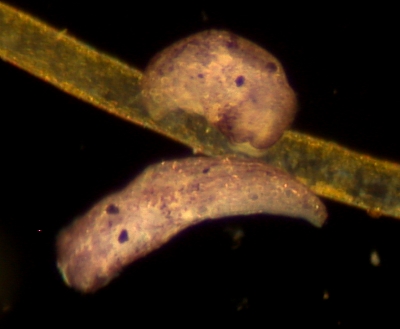
Dear Dr. Rudman,
I would like to refer you to two new references on Elysia clarki.
We used a variety of techniques (Molecular, Microscopical, and feeding experiments) to determine the algal sources of the sequestered chloroplasts in this species, and we investigated the feeding capabilities of juveniles over a wide range of potential algal food sources. To summarize, we found that adults in the field sequester chloroplasts from two species of Penicillus, (P. lamourouxii, P. capitatus), and two species of Halimeda, (H. incrassata, H. monile), however, juvenile slugs in the laboratory will only feed on fine, filamentous algae like Bryopsis or Derbesia. As the juveniles grow to adult size, they will switch food sources to Penicillus if presented with it.
I've also attached a photo, of juveniles (1 week post-metamorphosis) feeding on Bryopsis plumosa.
-
Curtis, N. E., S. E. Massey and S. K. Pierce. 2006. The symbiotic chloroplasts in the sacoglossan Elysia clarki are from several algal species. J. Invert. Biol., 125: 336-345.
-
Curtis, N. E., S. K. Pierce, S. E. Massey, J. A. Schwartz and T. K. Maugel. 2007. The intracellular, functional chloroplasts in adult sea slugs (Elysia clarki) come from several algal species, and are also different from those in juvenile slugs. Marine Biology, 150 (5): 797-806.
Thank you,
Nicholas Curtis
ncurtis2@mail.usf.edu
Curtis, N.C., 2007 (Jan 29) Elysia clarki feeding references. [Message in] Sea Slug Forum. Australian Museum, Sydney. Available from http://www.seaslugforum.net/find/19329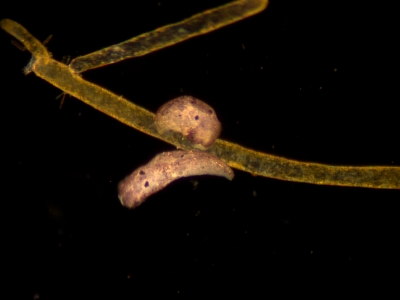
Dear Nick,
Thanks for keeping us up to date with your work on E. clarki. It is certainly developing into a fascinating story.
Best wishes,
Bill Rudman
Re: What's wrong with Elysia clarki?
September 9, 2006
From: Colin Redfern
Concerning message #17782:
Dear Bill,
My figured example of Elysia clarki was collected near the shoreline of a broad creek. In Abaco the species seems to occur most often in shallow water near moderately protected shorelines. These areas would be somewhat more exposed than the Florida habitat, but I haven't collected the species from an open reef environment.
Best wishes,
Colin
bahamianseashells@att.net
Redfern, C., 2006 (Sep 9) Re: What's wrong with Elysia clarki?. [Message in] Sea Slug Forum. Australian Museum, Sydney. Available from http://www.seaslugforum.net/find/17788Thanks Colin,
Bill Rudman
Re: What's wrong with Elysia clarki?
September 9, 2006
From: Colin Redfern
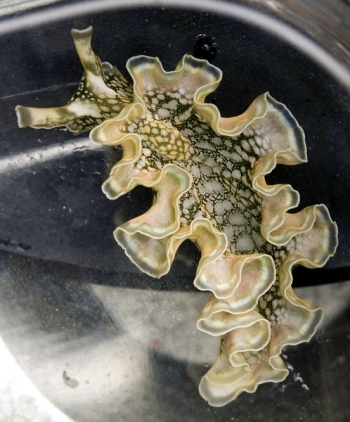
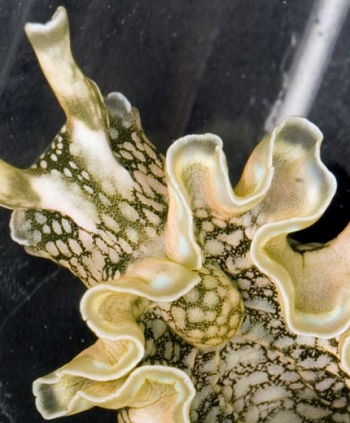
Concerning message #17766:
Dear Bill,
These three photos of a 22 mm example of Elysia clarki from the Bahamas are in response to your request for photos of E. crispata and E. clarki that show the sole of the foot and the front of the parapodia.
I was in Abaco, Bahamas last month, and made a point of collecting and photographing several specimens, all of which fit the description of E. clarki. In each case the sole of the foot was as shown here - (the figured animal is in the act of turning, showing the posterior end of the sole as well as part of the left flank). The pale spots are less numerous on the sole, and are not separated by as many smaller dots. Each animal also had a parapodial gap, but it appears that this feature can quite easily be concealed. This can happen if the parapodia are positioned in such a way as to close the gap, as shown here, or if they overlap slightly. In each case the gap was clearly visible on the preserved animal.
Locality: Treasure Cay, 1m, Abaco, Bahamas, western Atlantic, 22 August 2006, On Batophora . Length: 22mm. Photographer: Colin Redfern.
Best wishes,
Colin
bahamianseashells@att.net
Redfern, C., 2006 (Sep 9) Re: What's wrong with Elysia clarki?. [Message in] Sea Slug Forum. Australian Museum, Sydney. Available from http://www.seaslugforum.net/find/17782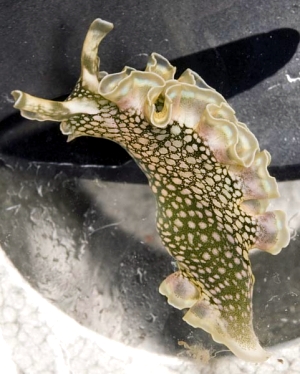
Dear Colin,
Thanks for this quick response. It's nice to get an unequivocal example of Elysia clarki relatively far from its type locality in Florida. It would be interesting to know a little about the locality in which you found this animal. In Florida, Skip Pierce says it is confined to the mangroves, man-made canals and similar structures, rather than open coral reefs. Were your specimens found in a similar habitat?
Best wishes,
Bill Rudman
Re: What's wrong with Elysia clarki?
September 8, 2006
From: Skip Pierce
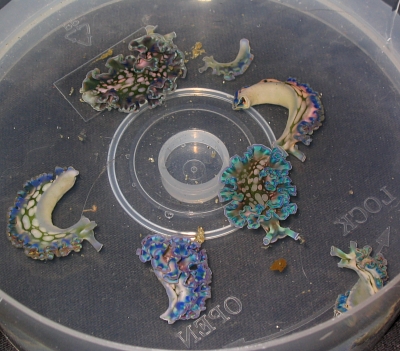
Concerning message #17766:
Hi Bill,
Hope you enjoying your holiday. I continue to be puzzled a bit about this issue. Your response to this message shows how easy it is to distinguish E. clarki from E. crispata, even from photos. I agree with your ID's. The photos in this message from Florida and the Bahamas are clearly E. crispata, while the Belize specimen is E. clarki. Again, I would like to stress that we have looked at thousands of E. clarki over a decade now. There is simply nowhere near the morphological variation in them that Valdez' claims. On the other hand, E. crispata does indeed show some variation, as the photos show, but not that overlap with E. clarki. I've attached another picture of several E. crispata taken by our colleague Colin Finney. You will first note the wide color variation - which never occurs in E. clarki - but the foot, parapodial fusion and blunt posterior end are all signature E. crispata. As our paper points out, we did look at probably 40-50 museum specimens from all around the Caribbean and the Bahamas, collected by many people over many decades. There is just no doubt that E. clarki is a distinctive species. Further morphological and habitat variation cannot just be switched on and off. My guess is that the extensive collecting proposed by Valdes (not nearly as easy to arrange as suggested by the way) might find that there are even more species currently being identified as E. crispata.
Locality: St. Thomas Virgin Islands, Caribbean. Photographer: Colin Finney.
Skip Pierce
pierce@cas.usf.edu
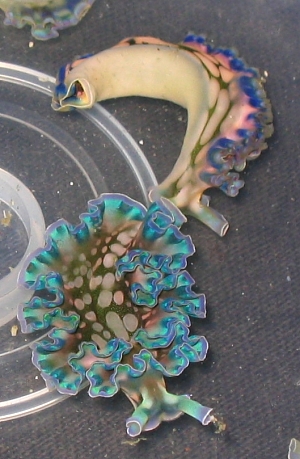
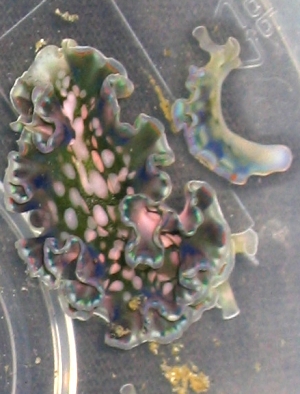
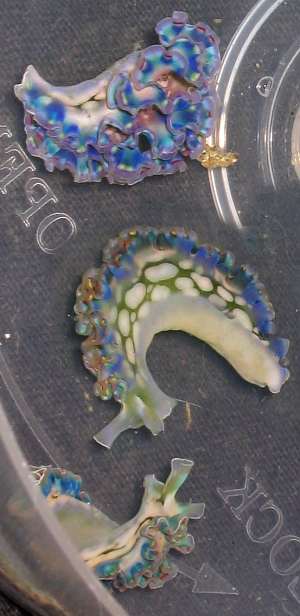
Dear Skip,
Thanks for this 'dish' shot showing variability in E. crispata. With a little digital magic I have rearranged the animals into three enlargements to show some detail.
Best wishes,
Bill Rudman
Re: What's wrong with Elysia clarki?
September 7, 2006
From: Angel Valdes
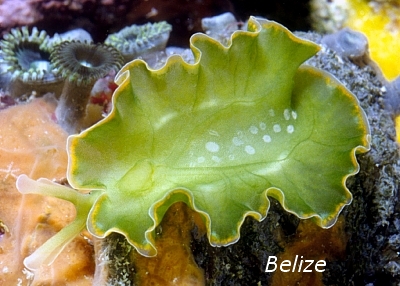
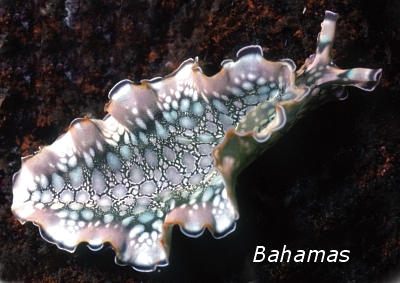
Concerning message #17695:
Dear Bill,
Thank you for initiating a discussion on the validity of E. clarki in the Forum. After reading your comments as well as the original description of this species, there are several things that come to mind. I agree that very often species are described based on a single population and this is common practice, especially in cases in which material is not readily available, or the species is rare. In this case though, I do not quite understand why the authors did not examined specimens from other populations throughout the Caribbean. Elysia crispata is the most common Caribbean opisthobranch. It is found in the upper subtidal, so no diving is required to collect specimens. There are dozens of photos and specimens available in numerous museum collections and this is the only Caribbean species consistently found by amateurs with limited experience collecting opisthobranchs. So, it would be very easy for anyone to gather a substantial collection of specimens throughout the Caribbean.
The reasons for the synonimization of E. clarki with E. crispata are not stated in detail in our book because of limited space. However I would like to provide here a more complete explanation. I have been collecting specimens of E. crispata for the last few years and I have now a sizable collection including material from Florida, Costa Rica, Panama, Curaçao and the US Virgin Islands. I have also examined specimens and photographs provided by Jeff Hamann from Honduras, Belize, Bahamas, Aruba and Jamaica. My conclusion is that the characters used to separate E. clarki from E. crispata are variable. First of all, the color and the complexity of the parapodia folding is extremely variable within populations and as far as I can see there is no correlation with geographic location. We have illustrated a little bit of the variability in our book, but there are many more color patterns that we have no space to include.
Regarding the anterior fusion of the parapodia, I have included in this message a photo of a specimen of E. crispata from a reef environment in Belize in which the parapodia are not fused anteriorly, and a photo of a specimen from a mangrove environment in Florida with the parapodia fused together. I also attached another photo of a specimen from the Bahamas resembling the original description of E. clarki, but with the parapodia fused anteriorly. I have not seen branches of the digestive gland in the foot sole of the Florida specimens I collected.
Regarding genetic differences, Pat Krug et al. have recently presented a paper in the American Malacological Society meeting in Seattle, looking at generic variation of several species of Caribbean Elysia. I quote from their abstract: "In E. crispata, private ancestral haplotypes were also recovered from most sites that were 6-8% divergent. Floridian specimens of E. crispata were recently described as a new species based on local adaptation and genetic distance, but our data suggests each island cluster may harbor a derived lineage, making descriptions premature until a full phylogeographic analysis can be completed."
I think the description of E. clarki is premature and I do not see consistent morphological differences between the Florida population and other Caribbean populations. The name E. clarki remains available and it could be reintroduced at any time but I strongly believe that a review of numerous Caribbean populations from different environments and geographic locations using morphological and molecular tools is the only way to provide enough evidence to maintain E. clarki as a valid species. In the meanwhile it is my opinion that it should be considered a synonym of E. crispata.
Best regards,
Angel
avaldes@nhm.org
Valdes, A., 2006 (Sep 7) Re: What's wrong with Elysia clarki?. [Message in] Sea Slug Forum. Australian Museum, Sydney. Available from http://www.seaslugforum.net/find/17766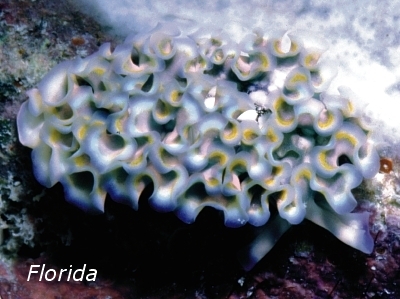
Dear Angel,
Thanks for your response. The photo from Belize you have sent is probably from the same series as the one already on the Forum [message #1656]. I added a note in May this year to that message saying it may be E. clarki, but in that photo the parapodial gap is not clear. Your photo definitley shoa the gap. My information was that this was a mangrove specimen, which would fit with E. clarki, not a reef specimen as you suggest.
This brings up an important point in this discussion. The only photo I had seen of this Belize form before today did not show either of the two points which seem critical in identifying these species externally - the parapodial gap and the digestive gland in the sole of the foot as I have discussed in earlier messages. You mention there are many photographs available of this common animal[s] which could be examined, but I suspect most if not all available photos will not clearly show these two features. When this topic first arose I searched the Forum, and all the published literature and websites I could find looking for photographs to see these features without success. In fact for such a common animal, it was extremely difficult to find an illustration or written description clearly describing the external morphology of E. crispata including that the rather vital point that the parapodia are fused anteriorly. So although it may be common, information on its salient points are not easy to find. One way would be to alert the many interested amateurs throughout the Caribbean to look out for these differences. I guess that is what I found disappointing about your decision in your excellent book, to effectivley censor E. clarki from the minds of the many readers your book will surely receive. It would have been a perfect way to encourage them to give Elysia 'crispata ' more than the normal passing glance they would give to something considered so common..
Concerning colour and parapodial folding - I specifically mentioned that these points were probably not that helpful in a discussion on these species because of the difficulty in quantifying them. Similarly, Pierce et al mention the way E. clarki rests with its parapodia open flat, a bit like descriptions of the mangrove dwelling species Elysia leucolegnote in the Indo-West Pacific. Although I think this behavioural difference and degree of parapodial folding are probably good characters, discussing them at present, would bog us down in trying to quantify the unmeasurable.
What I said we should do is try and test the two important external characters - the parapodial fusion and digestive gland ducts in the sole of the foot. Unfortunately none of your photos show both those features so we are no further ahead. Concerning habitat specificity. My advice is that the Belize animal is from a mangrove habitat so one of us is wrong. Concerning the Florida animal which looks to me like a 'typical' well-folded E. crispata - as I am at pains to repeat often, I have no personal experience with these animals, or the Caribbean, so I cannot comment on whether that is an unusual find or not, but from the writings of Pierce and his co-workers, it would seem to be.
Concerning the genetics. I remember a couple of years ago reading that there was more genetic variability in a troop of chimps in West Africa than in the whole world population of Homo sapiens. While these genetic analyses are very interesting, it seems we shouldn't defer to them when we have, what seem to me, to be good external morphological characters. I am not belittling genetics and DNA studies, but we have to be careful as morphologists not to consider them to be the answer to all our unanswerables. After all, geneticists and DNA workers spend as much time commenting on each other's work as morphologists do, so they can't have all the answers.
I am happy to invite participants to send photos from anywhere in the Caribbean of Elysia crispata and Elysia clarki, but there is a rule. All photos would have to be in a set of 2 or 3 showing the whole animal from above, the sole of the foot and the front of the parapodia to show whether it is fused or separate. If there is only one species, then surely we will find animals with fused parapodia and green patches of digestive gland in the sole of the foot.
Best wishes,
Bill Rudman
Re: What's wrong with Elysia clarki?
September 1, 2006
From: Skip Pierce
Concerning message #17670:
Hi Bill
The answer to your question is that, as you've answered it yourself, there is nothing wrong with E. clarki, especially if a comparison is made to the descriptions of several other elysiid species. I have not seen the book that you've reviewed, but from your comments, what is wrong here is the authors' opinion, which seems based on no new data, ignorance of the existing data and no research to support their opinion.
On the other hand, I think if you look at our paper describing E. clarki, you will find much more documentation, than regrettably, usually accompanies descriptions of elysiid species. Furthermore, our comparison of E. clarki with E. crispata covered many levels, from ecology, to feeding, to larval development, to symbiotic chloroplasts, to radular morphology, to digestive system morphology, to microscopic anatomy at both light and electron microscopic levels, to molecular biology - and the two species were consistently and, importantly, predictably different in EVERY characteristic in EVERY specimen - and we've looked at 1000s of specimens over many years - live and preserved. The differences hold up not only between E. crispata from the Virgin Islands and E. clarki, but also between E. crispata from Florida reefs and E. clarki, as well as among preserved specimens from a variety of locations - all of which we looked at. Not all are data is included in the published description because during a long and exhaustive gestation period, journal reviewers insisted, amongst other things, that the manuscript be shortened.
Some of the characters are subtle - but some, as you have mentioned, Bill -are major. In fact, the anterior gap vs fusion in the parapodia has been used by some authors as a genus-separating characteristic. According to some schemes, the fused parapodia suggest that E. crispata should not even be in Elysia. As you point out in your message, Bill, morphological and ecological characteristics of the two species do not overlap--ever. Furthermore, while we did not test any, the habitat differences between the two species imply an additional host of physiological and biochemical differences between them. All of that is why we decided to describe E. clarki as a distinct species. To simply invoke an opinion of population differences without any data to support it is merely arm waving. Instead, as you also point out, biochemistry, morphology and ecology are grounded in differences in DNA and, subsequently, proteomics. Such characteristics do not simply all appear or disappear at whim in every specimen in every population.
To come to a conclusion of synonomy without any data is naive and, I'm afraid, bad science. There are many taxonomic issues amongst the elysiids, many of which continually appear on the Forum and in the literature, that have been produced from over 150 years worth of opinions that have ignored data or not even bothered to collect data, but E. clarki is simply not one of them. I too would invite the book's authors to produce some data to support "intraspecific variability" - until then their synyomy is groundless.
Skip
pierce@cas.usf.edu
Pierce. S. K., 2006 (Sep 1) Re: What's wrong with Elysia clarki?. [Message in] Sea Slug Forum. Australian Museum, Sydney. Available from http://www.seaslugforum.net/find/17695Re: Damaged Elysia crispata
August 31, 2006
From: Nick Curtis
Concerning message #17549:
I have had first hand experiences with damaged E. clarki in our aquaria, and they have proven to be surprisingly resilient. It appears that as long as at least the head and pericardial sac are intact, the animal can survive and will continue to crawl around. The parapodia will regenerate fairly quickly around the damaged region, although, the slug may not grow back to its original size. I have also noticed that if the head is lost, the remainder of the body will survive for over a month, but will not move. I assume that the tissues continue to be sustained by the photosynthetic products of the chloroplasts. Unfortunately, I have never documented this with photography, so I encourage D. Rose to do so.
Nick Curtis
ncurtis2@mail.usf.edu
Curtis, N.E., 2006 (Aug 31) Re: Damaged Elysia crispata. [Message in] Sea Slug Forum. Australian Museum, Sydney. Available from http://www.seaslugforum.net/find/17684Thanks Nick,
I am sure many of us have regeneration stories like this but they are usually peripheral to the task we are doing so they never get properly documented. For example, I was amazed one time how fast aeolids could replace lost cerata but I can't remember how many days it took - just that is was fast.
I know of only a very few published papers on the topic. If anyone can help out with references it would be nice to include them on the Forum. I have a page for messages on regeneration on the Forum, but most messages on the topic are attached to particular species. If you do a Forum Search for regeneration you will find most of them.
Best wishes,
Bill Rudman
What's wrong with Elysia clarki?
August 30, 2006
From: Bill Rudman
I have been waiting with anticipation for the publication of Caribbean Sea Slugs [Valdes, Hamann, Behrens & DuPont, 2006] so when it arrived I dropped everything and spent an hour thumbing through it. As I state in my review, it is an excellent contribution to our knowledge. However, the treatment of Elysia clarki puzzles me. I noticed that it was not there and presumed that since it was only recently described, it had not made the cut off date. I was a bit surprised a couple of days later, when looking at what treatment they had given Marcus's problematic Elysia patina, to find that Elysia clarki was in fact in the book, but as very junior synonym ofElysia crispata. Synonymised within a month of publication must be some sort of record - and hardly time for reasonable reflection.
The authors reason for the synonymy was:
'Elysia clarki was described for the Florida Keys populations without comparison to other Caribbean populations except for specimens from the Virgin Islands. Morphological differences between Florida and Virgin Islands populations fit within the intraspecific variability of E. crispata.'
My reading of the original description of E. clarki was that the comparison with Virgin Islands specimens was included because that was the type locality of E. crispata - a sensible thing to do considering the possiblility of more than one species. To say that new species cannot be valid if based on single populations may be a goal we can aspire to, but it is far from normal practice. It is certainly desirable to have specimens from many localities when describing new species, but often such material is unavailable and all of us have described species from one or two specimens at times. In this case the species was based on populations which have been studied extensively by the authors for a number of years both in the field and in the lab. I find it strangely inconsistent for the authors to effectively dismiss E. clarki in this book and yet accept many Marcus' species which were often based on single preserved animals - species we don't know the colour or shape of one living animal let alone even a single population.
It is certainly true that there are similarities between E. crispata and E. clarki, that's presumably the reason E. clarki hasn't been recognised before. It is also important to realise that both species are found in Florida, but E. clarki is found only in mangrove areas and similar canal habitats while E. crispata is found in open reef localities. Are the differences then intraspecific - perhaps the result of environmental differences? I don't think so, and I certainly have not been told of any intermediates. I thought I had discussed these two species, and E. diomedea, quite clearly in an earlier message [#16728].
Let's forget colour variation and even the degree of folding to the parapodial edge, which are difficult to quantify, and concentrate on two major morphological differences.
Fused parapodia: Elysia crispata is unique amongst the elysiids in having the parapodia fused in the anterior midline. On the other hand, in E. clarki and E. diomedea, like all other species of Elysia, the parapodia do not fuse anteriorly. To me this is a major anatomical difference.To say that fused and unfused parapodia are part of normal intraspecific variation is not credible without some pretty convincing evidence.
Digestive gland in foot: Elysia clarki and E. diomedea both have branches of the digestive gland ramifying through the sole of the foot. These are easily seen as green lines or a network colouring the sole of the foot. E. crispata on the other hand does not. These are not variations. In starved animals the ducts may not be clearly visible in the first two species, but E. crispata, even when well fed, cannot grow such ducts in its foot.
These differences are well illustrated in my earlier message [#16728 ]. Although I am far from the Caribbean, these differences certainly appear real to me. I understand there is some genetic argument against E. clarki. I don't want to muddy the waters with a discussion on the efficacy of genetics and DNA in species determination; suffice to say that since morphology is controlled by DNA, if the genetics and DNA studies do not reflect the morphological differences then the genetical tests must be wanting. The first thing that needs to be addressed is why these clear morphological differences are being ignored. I think the onus is on those who do not accept E. clarki to show why major morphological differences which we would normally use to differentiate species don't apply in this case. Perhaps I am missing something? If so I would be grateful if someone could explain it to me.
Bill Rudman
Elysia diomedea & E. clarki in home aquarium?
May 30, 2006
From: Matt Pedersen
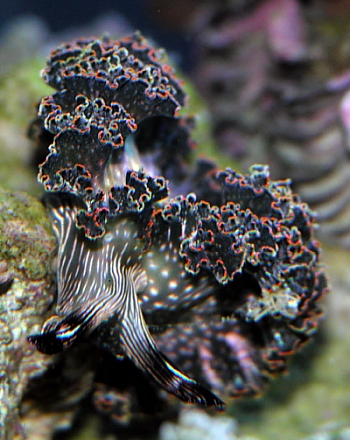
In my prior message regarding Elysia clarki [#15227 ] I laid out my quick plans for productive captive breeding & rearing of the species.
However, perhaps on a foolish whim, I came across two specimens of a different Elysia sp. which I have identified as E. diomedea. They now currently reside in the same aquarium as my pair of E. clarki.
My question is simple - as these two species do not occur sympatrically in nature, what are the chances that these two species could hybridize in a captive environment?
A more sinister proposition perhaps, but based on my limited experience with E. clarki, I would suspect that mating occurs well in advance of the actual deposition of the eggs, perhaps hours or even days. The observations of other aquarists have led me to wonder; could one mating produce several batches of eggs? Furthermore, could the sperm received during mating be stored for later use throughout the lifespan of the nudibranch?
I welcome your thoughts, and have included images of both my E. diomedea [upper photo ] and E. clarki [lower photo] for review.
Best Regards,
Matt Pedersen
matt@cichlidrecipe.com
Pedersen, M.P., 2006 (May 30) Elysia diomedea & E. clarki in home aquarium?. [Message in] Sea Slug Forum. Australian Museum, Sydney. Available from http://www.seaslugforum.net/find/15228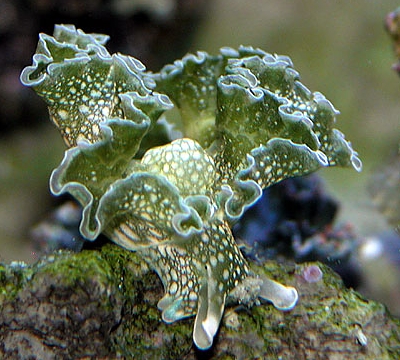
Dear Matt,
I am glad you had your whim to buy E. diomedea to go with your E. clarki. Your two photos are a very valuable complement to the message I am posting today [#16728] comparing those two species with 'true' E. crispata.
Concerning them cross-breeding - I suppose anything is possible, but I would be very surprised if they did. Concerning how long it takes them to lay eggs after mating, that varies with different species, and we don't know very much about any species. Sea slugs are hermaphrodite, with both a functional male and female system. However often the male system develops before the female one and their is some evidence to suggest sperm can be stored for some days or weeks after mating, but what occurs in your species I would not know.
Best wishes,
Bill Rudman
Elysia clarki breeding in the home aquarium
May 30, 2006
From: Matt Pedersen
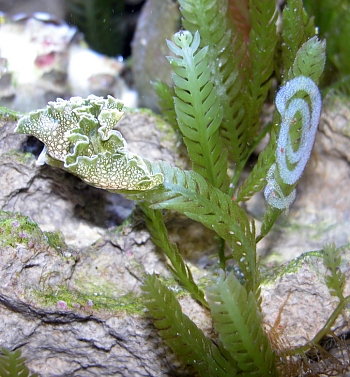
I'm seeking thoughts and advice on the breeding and rearing of Elysia crispata in the home aquarium. Not too long ago I added my first specimen, and after reading up a bit more was struck by the idea of attempting to intentionally propagate the species, if possible, rather than just getting "lucky" as many folks have in the past.
As my "luck" would have it, I obtained a second E. crispata earlier today. Within 6 hours of introduction to the aquarium, it appears that the 2nd specimen has laid an egg ribbon on one of the several Caulerpa sp. growing in the aquarium.
Initially I had observed this smaller specimen coiled around the Caulerpa and assumed it was feeding...observing a few hours later I found the string of eggs where the nudi had been "feeding". While I can't say with 100% certainty that these eggs were indeed produced by the nudi (as I did not actually witness the laying of the eggs), there isn't much else in the aquarium that could have produced the egg ribbon in the elapsed time span! So much for "intentional" vs. "random" breeding!
The question is now, what next? I suspect while there's little in the aquarium that would feed on the eggs, allowing the larvae to develop in the tank could be less than productive. I've looked into rearing schemes for other Nudibranchs, particularly an AZAA Article Online detailing the culture of Berghia sp. (http://www.breedersregistry.org/Reprints/azaa/1996/berghia_azaa.htm ).
My initial thoughts have been to cut a portion of the Caulerpa (and egg mass) away and separate them to a non-filtered container for hatching an initial rearing. The remaining portion of the eggs would be allowed to develop without further "help", still attatched at it's original site of deposit, in the main aquarium. Will splitting the egg mass cause damage/decay/demise of the entire egg mass?
If the splitting would be successful, I believe I can find some macroalgae that would sustain the separated larvae, hopefully getting them to a size where they could then be distributed.
As if this weren't enough, along with the 2nd E. crispata I introduced today, I came across a pair of "different" Lettuce Nudibranchs. After examination of the species photographs contained on this website, I am convinced that these 2 new specimens are Elysia diomedea. My concerns regarding the "polyculture" of these two species side-by-side are raised in a forthcoming message.
I've included some pics of the E. crispata and the eggs - my apologies if they are a bit large but I felt the detail might be helpful.
Best Regards,
Matt Pedersen
matt@cichlidrecipe.com
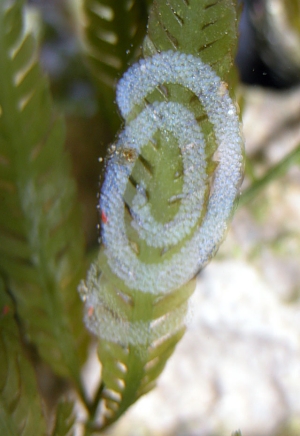
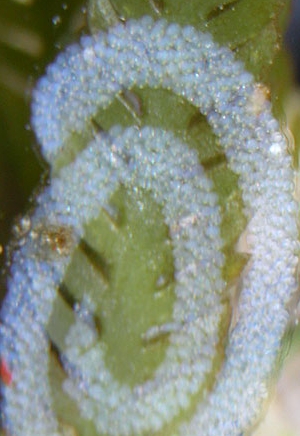
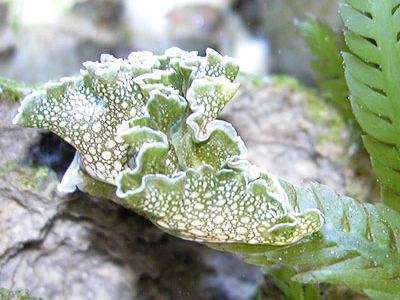
Dear Matt,
Sorry I didn't reply immediately to your message but I was expecting some changes to the 'Lettuce Slug' story any day. As you will see by my message today [#16727], your slug is the recently named species Elysia clarki.
Concerning looking after the larvae you are in luck because this species has swimming larvae which don't feed, and only spend 4 or 5 days in the water before turning into small crawling slugs. You'll see a couple of species listed on the Fact Sheet as juvenile food, but it is more than possible that they feed on other green algae as well. Certainly as you will have seen in earlier messages, other people have had success in their aquaria with just the algae common green algae growing in their tanks. I suspect all the aquarium success stories on the Forum refer to E. clarki rather than E, crispata. Because they keep chloroplasts alive in their tissues [see solar powered slugs] you will need aquarium lights that assist plant growth. Let us know if you have any success
Best wishes,
Bill Rudman
Elysia clarki, E. diomedea and E. crispata
May 30, 2006
From: Bill Rudman
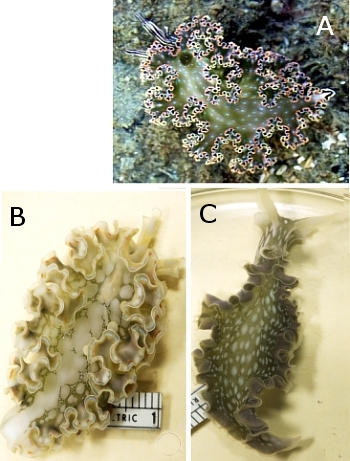
UPPER PHOTO: A. E. diomedea Photo: Rebecca Rissanen. B. E. crispata. C. E. clarki. Photos: S.K. Pierce.
In their recent description of Elysia clarki, the authors (Pierce et al, 2006) argue that there are many differences from E. crispata in habitat, gross and microscopic anatomy, food preferences of juveniles, sources of symbiotic chloroplasts and their localization within the digestive tubules, radular morphology, and nucleic acid sequences of mitochondrial genes.
Since these two species have been confused as one species for many years, I thought it would be useful to summarise some of the key differences between these species which can be seen by field biologists. It's not much value if you have to DNA test every specimen before you can be sure of its identity. At present E. clarki is known only from mangrove swamps, mooring canals and borrow pits in the Florida Keys, while E. crispata is considered to be found in more open reef waters throughout the Caribbean. It would be interesting now to find out whether E. clarki also has a wider distribution, perhaps in similar habitats throughout the Caribbean. For example, I suspect the animal from Belize [message #1656 ] is this new species..
Colour: Well-fed E. clarki are nearly uniformly green, interspersed with comparatively small round or oval translucent whitish spots. The green colour is present on most external surfaces including much of the head, the parapodia and the sole of the foot. In E. crispata, the green colouration is a minor part of the colour pattern, and does not extend onto the sole of the foot which is a translucent opaque whitish colour. Both species can have bluish, orange and greenish bands at the parapodial edge. Elysia diomedea, is similar to E. clarki.in the distribution of green, but while in E. clarki, the green on the sole of the foot is interspersed with rounded and oval whitish spots, in E. diomedea the translucent white regions are broken lines running parallel to the long axis of the body. E. diomedea also differs in having a characteristic pattern of black and white lines running down the rhinophores onto the head. Other differences in colour are the small blue spots scattered over the dorsum and inner walls of the parapodia, and a border of black spots, and sometimes red or orange spots, on the parapodial edge.
Parapodia: Elysia crispata is unique in having the parapodia fused in the anterior midline. In both the other species there is a small gap in the anterior midline. In both E. crispata and E. diomedea the parapodial edges are extremely folded with both primary and secondary folds. E. clarki, by comparison, has only primary folding, and often when at rest in sunlight, the parapodia will open and flatten out inot a leaf shape.
-
Pierce, S.K., Curtis, N.E., Massey, S.E., Bass, A.L., Karl, S.A. & Finney, C.M. (2006) A morphological and molecular comparison between Elysia crispata and a new species of kleptoplastic sacoglossan sea slug (Gastropoda: Opisthobranchia) from the Florida Keys, USA. Molluscan Research, 26(1): 23-38
Best wishes
Bill Rudman
LOWER PHOTOS: Right - showing anterior parapodia. Left - showing ventral colouration. A. E. crispata, B, E. clarki, C. E. diomedea
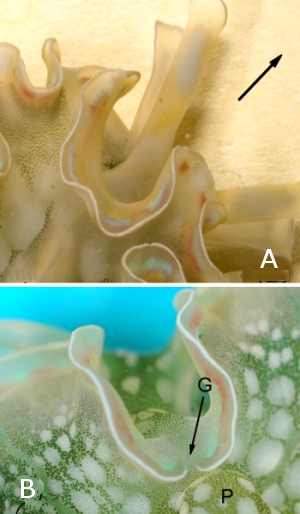
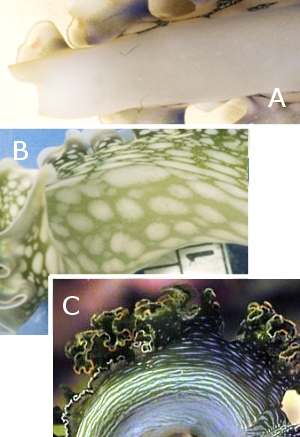
A new Elysia from Florida
May 30, 2006
From: Bill Rudman
In early 2005 Professor Skip Pierce sent photos of two animals [message #12896] which he and many others had assumed were Elysia crispata. Although he didn't say much, he implied that he doubted they were both the same. What was important to him and his team was that the doubtful ' E. crispata ' was the animal which his laboratory was using in their chloroplast symbiosis studies. Last week a paper describing this as a new species, E. clarki, after the late Professor Kerry B. Clark of the Florida Institute of Technology, in recognition of his extensive studies of elysiid slugs in the Florida Keys.
I have posted a separate message [#16728 ] comparing this new species with E. crispata and E. diomedea. Quite a few earlier messages on the Forum, including most of the aquarium accounts, would seem to refer to the new species rather than E. crispata.I have prepared a Fact Sheet on E. clarki and upgraded the esxisting ones on the other two species.
- Pierce, S.K., Curtis, N.E., Massey, S.E., Bass, A.L., Karl, S.A. & Finney, C.M. (2006) A morphological and molecular comparison between Elysia crispata and a new species of kleptoplastic sacoglossan sea slug (Gastropoda: Opisthobranchia) from the Florida Keys, USA. Molluscan Research, 26(1): 23-38
Bill Rudman
Rudman, W.B., 2006 (May 30) A new Elysia from Florida. [Message in] Sea Slug Forum. Australian Museum, Sydney. Available from http://www.seaslugforum.net/find/16727Lettuce Sea Slug behavior and feeding
April 13, 2006
From: Patrick Glenn
Note added 30 May 2006: This is most probably Elysia clarki, a new species which was previously considered a colour form of E. crispata.
I have 4 lettuce sea slugs [Elysia crispata ] in my 29g reef (yeah, probably 2 if not 3 too many - I ordered 2 and the online store sent me 4). I have had them in there for a couple months. [Length: 1/2" to 1"] Only one of them explores the entire tank, another explores sometimes, but the other two and the "sometimes" one mostly hang out on the glass at the top of the tank, always at about the same spot, in the direct flow of my power filter and obviously near the light, and the two don't move hardly at all.
I have a couple of times taken them all and placed them within the rock but they end up back at the tank top. My question is, is this considered "normal"? I figured they are partially photosynthetic but they are getting little if any solid food, other than what they may be filtering/catching in the water flow. should I be concerned with their health? they so far don't seem to be adversely affected, at least on the outside.
As a supplement I was gonna place some Chaetomorpha (sp?) from my refugium in the tank for them. would this be good for them? or perhaps a form of Caulerpa.
Patrick
pglenn_test@yahoo.com
Glenn, P., 2006 (Apr 13) Lettuce Sea Slug behavior and feeding. [Message in] Sea Slug Forum. Australian Museum, Sydney. Available from http://www.seaslugforum.net/find/16298Dear Patrick,
Since living in an aquarium is far from normal for these animals it is hard to answer your question about what is normal. Some times in aquaria, animals will seem to take a liking to being near a water current or even an air bubbler but it is often an individual thing rather than a species thing so I have no idea why they do it. Your animals are 'solar powered' to some extent so as long as the chloroplasts in their tissues survive I guess they can get nutrition from the chloroplast photosynthesis. I guess the test is when they need to replace the chloroplasts, which don't survive for ever. There seems to be some confusion at present over just how many different algae E. crispata eats to obtain chloroplasts so I cant really give you advice there. When you say you plan to put some ' Chaetomorpha from your refugium' in for the Elysia to eat, I guess you are using ' Chaetomorpha' loosely. Anything is worth a try but these animals feed by sucking the sap out of the algae so you need to put in living plants still attached to something. Don't just pull off some filaments and throw them in. I don't think that would work. Perhaps if you put some rocks in your refugium to grow green algae you could set up a crop rotation system moving the rocks in and out of the aquarium as the slugs cropped the algae.
Best wishes,
Bill Rudman
What to feed Elysia crispata?
April 11, 2006
From: Alexandra Ahnide
Note added 30 May 2006: This is most probably Elysia clarki, a new species which was previously considered a colour form of E. crispata
I have had three Lettuce slugs [Elysia crispata ] in my reef tank for about two weeks. I want to make sure they are well fed. Is there anything I can ask for at my local fish store to supplement their diet?
I have plenty of algae, but it's quickly disappearing . . .
I was thinking of trying Nori used for Sushi, since I've seen sheets floating in the tanks at the store?
Thank you,
Michele
Thedancecoop@hotmail.com
Ahnide, A., 2006 (Apr 11) What to feed Elysia crispata?. [Message in] Sea Slug Forum. Australian Museum, Sydney. Available from http://www.seaslugforum.net/find/16230Dear Alexandra,
I guess what they like to eat in your tank is what is disappearing. I am afraid the particular algae they eat is not available commerially but it seems as long as you have a light which aids photosynthesis and so keeps the plants growing, lettuce slugs seem to survive quite happily. Lettuce slugs are one of the solar-powered slugs which you can read about on the Forum, so I suspect feeding them artificial food which doesn't have chloroplasts will not be the right thing
Best wishes,
Bill Rudman
Elysia crispata feeding and babies
January 31, 2006
From: Willem Bermel
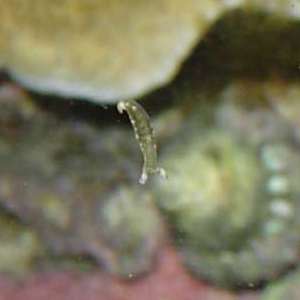
Note added 30 May 2006: This is most probably Elysia clarki, a new species which was previously considered a colour form of E. crispata
Concerning message #15149:
First thanks for providing this forum. It has served me well when looking for information that I could not find elsewhere. Back to the Elysia crispata. I too can confirm that they can live on Bryopsis as this is the only algae in my aquarium. I will attach a picture of one before the parapodia begin to become frilly. I have seen several babies with folded parapodia just like in Jeff Zimmerman's post [#4019 ], but this is the 'youngest' one I have seen.
Locality: Aquarium - from Atlantic. Length: 1 1/2 mm. 23 January 2006. Photographer: Willem Bermel
Memphis, TN
Willem Bermel
willember@hotmail.com
Bermel, W., 2006 (Jan 31) Elysia crispata feeding and babies. [Message in] Sea Slug Forum. Australian Museum, Sydney. Available from http://www.seaslugforum.net/find/15669Thanks Willem,
Bill Rudman
Re: Colour in Elysia (again)
November 7, 2005
From: Anne DuPont
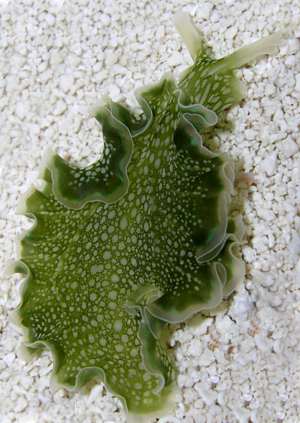
Note added 30 May 2006: This is Elysia clarki, a new species which was previously considered a colour form of E. crispata
Dear Bill,
In reading Skip's message regarding color in Elysia [#15154], here are some photos of Elysia crispata taken in the Florida Keys this summer that show the orange band on the edge of the parapodia very well. (These were found in the mangrove roots in a canal and moved to the sand for a better photo.)
Locality: Long Key, (Florida Keys, East coast), Florida, USA. Depth: 5 feet. in Mangrove Canal. Length: Approximately 45 mm in length. 2 June 2005. Photographer: Anne DuPont
Cordially,
Anne
akdupont@bellsouth.net
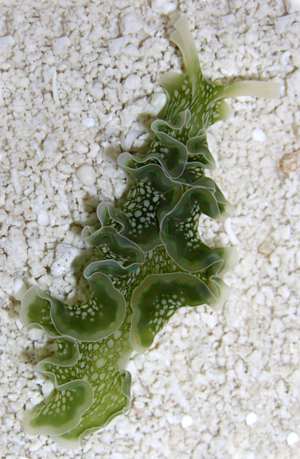

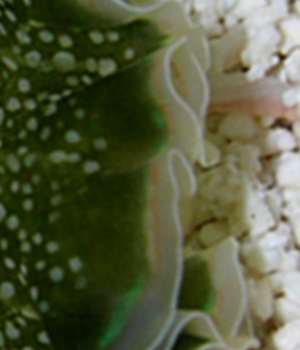
Dear Anne,
Thanks for these photos. I think this is part of the puzzle in an earlier message from Skip Pierce [#12896]. I understand there is a paper due to be published soon.
Best wishes,
Bill Rudman
Re: Lettuce sea slug - breeding success
June 27, 2003
From: Vincent
Note added 30 May 2006: This is most probably Elysia clarki, a new species which was previously considered a colour form of E. crispata
Concerning Rick's success with Elysia crispata in his aquarium. Apparently not all emerald crabs do ignore them. I came home with two an hour and a half ago, and I now have about two thirds of one, and that because I managed to pry it away from my crab.
Vincent
vpb@cfl.rr.com
Vincent, 2003 (Jun 27) Re: Lettuce sea slug - breeding success. [Message in] Sea Slug Forum. Australian Museum, Sydney. Available from http://www.seaslugforum.net/find/10154Bad Luck Vincent,
I don't have much experience with keeping aquaria, but one thing I discovered - and surely not for the first time - is that crustacea and octopus can't be trusted
Cheers
Bill Rudman
Lettuce sea slug - breeding success
May 31, 2003
From: Rick Hahn
Note added 30 May 2006: This is most probably Elysia clarki, a new species which was previously considered a colour form of E. crispata
I live in Grand Rapids, Michigan, USA. I've been running reef tanks for about 4 years and recently set up a 75 gal. with VHO lighting and added two of these critters ][Elysia crispata]. One disappeared after about a month which was disappointing, but the other seemed to thrive on the various algae bloom cycles that the tank went through. I have had to move my tank to another house last week and as I was checking the tank today to check on any stressed animals or corals I noticed a baby lettuce slug on the front glass seemingly at rest, spread into a dot on the glass. At the back and sides of the tank I discovered several more, which all appeared to be feeding on the algae bloom that appears on the glass. The only activity with the adult that seemed different lately was that it spent a lot of time in the Caulerpa (I have two types mixed in the tank) and two days ago I had a large Caulerpa die off. Today there are babies everywhere, about 1/8 - 1/4 inch long depending on activity level. The adult also spends a lot of time trying to get at the brown algae in my overflow and managed to get into it for about three days before I discovered it whereabouts and put it back into the tank. I have noticed that even in the same tank and eating the same (supposedly) food there are still color variations in the baby slugs (light green, med-dark green, blue-green, and green with bluish fringe). They are great for algae control and the snails, hermits, emeraldcrab, and peppermint shrimp I have ignore them. I had heard that they are hard to keep and that water salinity and quality are important to them, but the adult I have went through some major changes last week and seems to be thriving. I do recommend VHO or metal halide lighting for anyone trying to keep them as the info here tells me they use photosynthesis also. Lighting is a huge factor in keeping many saltwater creatures alive and healthy, and if you want to raise them.
The local saltwater/reef aquarium shops will usually buy or give store credit for tank raised critters since they are usually more adaptable than wild caught and more reef tank owners prefer tank raised for environmental reasons. Hope I had some useful info for those who want to try to raise them and have not been in the hobby before.
Rick Hahn
Rick_Hahn@Hotmail .com
Hahn, R., 2003 (May 31) Lettuce sea slug - breeding success. [Message in] Sea Slug Forum. Australian Museum, Sydney. Available from http://www.seaslugforum.net/find/10114Thanks Rick,
It's great to hear success stories about tank bred animals.
Best wishes,
Bill Rudman
Re: Gene transfer - Elysia crispata
May 5, 2003
From: Skip Pierce
Note added 30 May 2006: This is most probably Elysia clarki, a new species which was previously considered a colour form of E. crispata
Hi Bill
There aren't a lot of answers yet to the questions you and Philip have asked. I think it is fair to say that as genomes get sequenced it is becoming obvious that genes have been transferred all over the place among species. It probably occurs a lot in nature-but it probably doesn't work (in a functional sense) most of the time. Not only does the gene have to get from the nucleus of one organism to the other, but it needs to get integrated into the genome correctly, expressed, translated, etc. Furthermore, the protein produced needs to get to the right place, folded appropriately, inserted into the correct organelle, etc. -- All very tall orders for a gene and its product in a foreign cytoplasm, I think. There are several mechanisms around to get the genes moved. For example, we think (with out much evidence) that retroviruses may be involved in the Elysia instance, but there are certainly other well-known possibilities for transfer mechanisms. I'm hesitant to say much more specific yet about Elysia -- it may be the result that those species with the longest-lived chloroplast symbiosis have a relatively large number of transferred genes - but maybe they just have less demanding chloroplasts. Somebody needs to do a fair amount of sequencing to answer your questions, Bill, and not knowing fundamental issues like what slug is eating which algae makes it tough - which is why everybody should tune into the Forum.
Skip
Pierce@chuma1.cas.usf.edu
Pierce, S., 2003 (May 5) Re: Gene transfer - Elysia crispata. [Message in] Sea Slug Forum. Australian Museum, Sydney. Available from http://www.seaslugforum.net/find/9856Re: Algal genes in Elysia crispata
May 3, 2003
From: Philip Cromwell
Note added 30 May 2006: This is most probably Elysia clarki, a new species which was previously considered a colour form of E. crispata
Bill & Skip,
This conversation seems a little vague on the point of how the genes became a part of the slugs DNA. (This is from the point of view of a hobbiest not a biologist.)
Bill seems to imply that the genomic sequence could somehow be transferred from the alga to the slug and embedded in the DNA. If this is possible, I do not know, but it seems unlikely.
For some background information, my senior project in electrical engineering was to use a reprogrammable chip as a physical "body" for a genetic algorithm to evolve certain behaviors in response to stimulus. In the literature (much of which can be found at Adrian Thompson's home page http://www.cogs.susx.ac.uk/users/adrianth/ade.html) there is a suggestion that "junk" DNA, that currently contributes little/nothing to the function of the species, can become an evolutionary path to a more advantageous configuration (genetic sequence).
To bring this back to seaslugs, a population of slugs that is already using chloroplasts, would need to go through the same mutations, and have enough viable offspring to carry the new genetic sequence forward. This would be a "luck of the draw" situation, but certainly possible. Once obtained, however, this ability would certainly give its species great advantages over those without it. So, if direct transfer of the genetic sequence from alga to slug were possible, this would probably need to be done in each new slug. If it is just an evolutionary modification to the DNA, this sequence would be automatically transferred to the offspring.
If I'm way off base here, let me know.
Thanks,
Phil
chiron42@msn.com
Cromwell, P., 2003 (May 3) Re: Algal genes in Elysia crispata. [Message in] Sea Slug Forum. Australian Museum, Sydney. Available from http://www.seaslugforum.net/find/9844Thanks Phil,
No you are not way off base at all. I am sure Skip can give a better answer than I, and in fact his second message answers part of it. An excellent summary paper on this topic - which finishes with a paragraph on lateral gene transfer - is worth getting hold of.
• Mary E. Rumpho, Elizabeth J. Summer, and James R. Manhart (2000) Solar-Powered Sea Slugs. Mollusc/Algal Chloroplast Symbiosis. Plant Physiology, 123: 29-38.
Have a look at Liz Summer's earlier message about the paper.
Best wishes,
Bill Rudman
Re: Elysia crispata and algal genes
May 3, 2003
From: Skip Pierce
Note added 30 May 2006: This is most probably Elysia clarki, a new species which was previously considered a colour form of E. crispata
Hi Bill
In answer to your question, the transferred genes have become part of the slug genome, so they do not need to be reaquired in each generation - they are already there waiting for the chloroplasts to appear as the juvenile slugs begin to feed. Actually, reacquiring in each generation could be a daunting task, because it would have to happen in every cell (well at least in those where the plastids reside), in every slug, in every generation. Be much more effective to have the gene in the germ cells. We have some fanciful ideas about how the initial gene transfer might have occurred (via retrovirus), but we do not yet have any direct evidence for that. We are pleased that you and your students found the work interesting.
Skip
pierce@chuma1.cas.usf.edu
Pierce, S., 2003 (May 3) Re: Elysia crispata and algal genes. [Message in] Sea Slug Forum. Australian Museum, Sydney. Available from http://www.seaslugforum.net/find/9842Thanks Skip,
The reason I asked is that although this is the obvious solution, it does raise a few interesting questions of its own. For example are the transferred algal genes specific to the species of algae that E. crispata feeds on or are they 'basal' or what you might call 'root' genes that can work for the chloroplasts of other related algae? Why I ask is that, as you know, there are a number of sacoglossans with similar well-developed plastid symbioses. If the symbioses have evolved independently in each case then lateral gene transfer must have occurred a number of times. Alternatively, if all the sacoglossans are related and have arisen from an 'ancestor' in which a unique lateral gene transfer event took place, then all the species arising from that ancestor would need to still be eating the ancestor's food plant, or the transferred algal genes would need to be basic enough to operate the plastids of the different species of algae the descendent sacoglossan species now eat. It's certainly an exciting field.
Bill Rudman
Algal genes in Elysia crispata
May 2, 2003
From: Skip Pierce
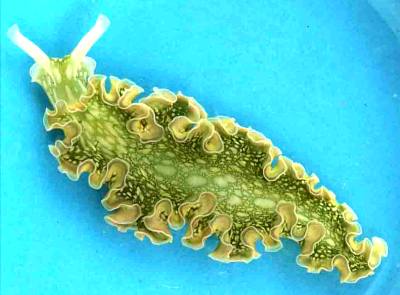
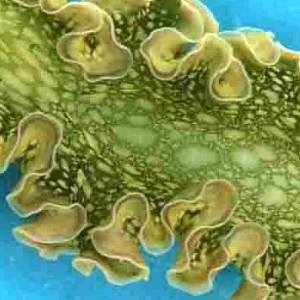
Note added 30 May 2006: This is most probably Elysia clarki, a new species which was previously considered a colour form of E. crispata
NOTE: the paper referred to below is now published:
• Pierce, S.K., Massey, S.E., Hanten, J.J. &. Curtis, N.E. (2003). Horizontal Transfer of Functional Nuclear Genes Between Multicellular Organisms. Biological Bulletin, 204: 237-240.
Hi Bill
A while back you invited me to say a word about my research program. I didn't answer because we were sort of in mid experiment. You might be interested to know that, after a few years of searching, we (well, my post-doc Steve Massey and a graduate student, Nick Curtis, who get to work in the lab while I do administrative duties) have developed some pretty solid molecular evidence showing at least one gene that codes for a chloroplast protein is located in the genomic DNA of a sacoglossan slug. The paper reporting the results has been accepted and will be out in the June issue of the Biological Bulletin. As you know many species of Elysia eat particular species of coenocytic algae and certain cells that line the digestive diverticula capture large numbers of intact chloroplasts as the eaten algae passes through the gut. So many plastids are captured that the slugs are green—in fact the density of chloroplasts in the slug is often greater than in the algae. The plastids reside in the cytoplasm of the slug cell, in some species for months, continuing to photosynthesize. So, if you shine light on the slug, it fixes carbon and produces oxygen as if it were a plant. To make a long story short, continued photosynthesis requires the synthesis of certain chloroplast proteins, many of which are coded in the algal nuclear genome. We had obtained a bunch of circumstantial evidence that genes for some of the light harvesting proteins of chloroplasts from the chromophytic alga, Vaucheria litorea, were being synthesized on cytoplasmic ribosomes in Elysia chlorotica, implying that the genes were in the genomic DNA of the host cell. Since finding the genes for those particular proteins was proving problematical for a variety of reasons (lack of algal sequence data, severe lack of sequence conservation, no amino acid sequence data, etc), we began looking at other species, in particular, Elysia crispata. There are several reports in the literature about what alga this species eats, all of which are wrong, I think (we'll publish on that issue later). However, after doing a variety of experiments, which are described in the Biol. Bull. paper, we were able to locate a gene for a chloroplast protein, fucoxanthine-chlorophyll binding protein, in the E. crispata DNA. Some species of Elysia, like E. rufescens, for example, do not seem to be able to maintain the plastids for more than a few days—so you might not expect that algal genes have been transferred in them—but species like E. chlorotica, E. viridis, E. crispata among others, that keep the plastids active for months may have a variety of algal nuclear genes present in the slug DNA. If that turns out to be the case, these slugs may turn out to be important models of not only endosymbiosis, but for things like genetic therapy (although so far, NIH has shown no interest) and mechanisms of evolution. We have some ideas about the mechanism of gene transfer-but no data.
I have included an image of E. crispata that was collected in the Florida Keys, approx. 3cm long.
Skip
pierce@chuma1.cas.usf.edu
Pierce, S.K., 2003 (May 2) Algal genes in Elysia crispata. [Message in] Sea Slug Forum. Australian Museum, Sydney. Available from http://www.seaslugforum.net/find/9830Thanks Skip,
It's exciting stuff. Do you think the algal genetic material is passed on from one slug generation to the next or does it need to be implanted anew each generation?
At the mollusc course we ran earlier this year I used a couple of earlier publications you contributed to as seminar discussion papers and the whole topic of algal-slug symbiosis, and its implications, produced some of the most animated, lively, & intelligent discussion in the 2 week course.
• Green, B.J., Li, W-Y., Manhart, J.R., Fox, T.C., Summer, E.J., Kennedy, R.A., Pierce, S.K. & Rumpho, M.E. (2000) Mollusc-Algal Chloroplast Endosymbiosis. Photosynthesis, Thylakoid Protein Maintenance, and Chloroplast Gene Expression Continue for Many Months in the Absence of the Algal Nucleus. Plant Physiology, 124: 331-342.
• Hanten, J.J. and S.K. Pierce. (2001) Synthesis of several light-harvesting complex I polypeptides is blocked by cycloheximide in symbiotic chloroplasts in the sea slug, Elysia chlorotica (Gould): A case for horizontal gene transfer between alga and animal? Biological Bulletin, 201: 33-44.
Best wishes,
Bill Rudman
Elysia crispata babies
December 30, 2002
From: Joe Bongiorno
Note added 30 May 2006: This is most probably Elysia clarki, a new species which was previously considered a colour form of E. crispata
Hi,
Concerning my earlier message: Well, it appears that 6 baby Elysia crispata sea slugs were born and are walking about a big patch of green filamentous algae. I could really use some advice as to how to keep these guys alive. Here's the specks:
150 gallon tank utilizing plenum system with lots of live rock, sand, crushed coral, and some soft corals.
Fish: 3 Mandarin Dragonettes
Inverts: cucumbers, snails, emerald crabs, Sally Lightfoot crab, various serpent stars, sea urchin, bubble-tip anenome.
I've been keeping everyone away from the green algae as best I can ... Is there anything else I should be doing to help these little guys grow into adulthood??
Joe Bongiorno
thesithempire@msn.com
Bongiorno, J., 2002 (Dec 30) Elysia crispata babies. [Message in] Sea Slug Forum. Australian Museum, Sydney. Available from http://www.seaslugforum.net/find/8756Congratulations Joe,
Nothing like a surprise Christmas present. Considering your 'babies' have survived to a size that you can see them, I would guess they have the food and physical conditions they require. Whether they will survive the other inhabitants of your tank is, I guess, one of the exciting aspects of keeping an aquarium. Many slugs, including this species do store nasty chemicals in their bodies which probably deter potential predators so its possible they are not attractive food items for your other aquarium inhabitants. All I can suggest is that you keep a watchful eye on them and if they start disappearing or look as though they are being nibbled, you may have to consider separating them by a divider or getting a second tank
Cheers,
Bill Rudman
Re: Baby slugs!
December 18, 2002
From: Joe Bongiorno
Note added 30 May 2006: This is most probably Elysia clarki, a new species which was previously considered a colour form of E. crispata
Hi Bill,
Thanks for your response. I'm still in shock over their loss and subsequent disappearance. I guess it was kind of foolish of me to get attached to creatures that live so brief a time. As regards food, I have a lot of filamentous green algae which they seemed to attach themselves to (as well as some brown algae). I also have some Caulerpa or grape algae, although I never saw them feed off that. These guys seemed really healthy and grew quite large in the short time they were here. I think that's why it was such a shock to have them suddenly vanish overnight! I wonder if their deaths are triggered by their laying of eggs ... The baby and other remaining member continue to do fine. I look forward to the new babies to come, but I do wish the fish store had warned me of their too short lifespan!
Joe Bongiorno
thesithempire@msn.com
Bongiorno, J., 2002 (Dec 18) Re: Baby slugs!. [Message in] Sea Slug Forum. Australian Museum, Sydney. Available from http://www.seaslugforum.net/find/8658Re: Baby slugs!
December 10, 2002
From: Joe Bongiorno
Note added 30 May 2006: This is most probably Elysia clarki, a new species which was previously considered a colour form of E. crispata
To Jeff (or anyone that can help),
I have the same situation as you described. I started off with 4 adult Lettuce Slugs and 1 baby, and literally overnight, am down to 1 adult and 1 baby! There are spiral forms (at least two) which I've been reading seem to be the eggs. While that's good news, I'm concerned about my missing 3 guys! Did you ever find out exactly what happens to them? They can't just disappear! There was one in particular that I grew quite fond of (he was the explorer) and I was afraid a big bristleworm might be responsible (as there are no fish in the tank yet or anything else that could harm them). There are no pumps or areas where they could hurt themselves (the tank is running on the plenum system and 2 Aquamasters
Joe Bongiorno
thesithempire@msn.com
Bongiorno, J., 2002 (Dec 10) Re: Baby slugs!. [Message in] Sea Slug Forum. Australian Museum, Sydney. Available from http://www.seaslugforum.net/find/8624Dear Joe,
In Jeff's first message he did report losing some animals but if you look at his later messages, you will see they were replaced by a successful crop of babies. It is important to realise that most slugs have a short lifecycle, few lasting more than about a year, and many lasting for only a few months. It is possible your 'lost' animals have died. If this is so, then it is is also possible that you missed the dead animal as they rot very quickly. The frilly folds, or parapodia, are only a few cells thick and could easily rot and disappear overnight.
I assume you have the right algae for them to eat? My advice is to keep your fingers crossed and hope you end up with a crop of babies.
Best wishes,
Bill Rudman
Bifid rhinophores in Elysia crispata
September 12, 2002
From: Anna L. Bass
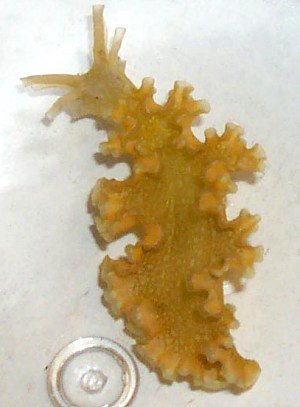
Note added 30 May 2006: This is most probably Elysia clarki, a new species which was previously considered a colour form of E. crispata
Hello,
Just wanted to share this little creature with you. I found it while snorkeling on the Florida Bay side of the Florida Keys, USA. It was the only individual I saw in the area which was dominated by Halimeda and Bataphora. It is approximately 4cm in length and is still living in a tank. I was curious as to how common the presence of 2 pairs of rhinophores is.
PS: Nick Curtis (USF) took this photo.
Best Regards,
Anna Bass
abass@helios.acomp.usf.edu
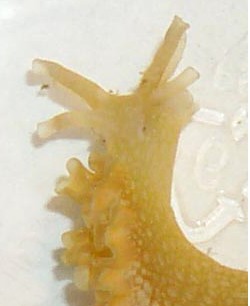
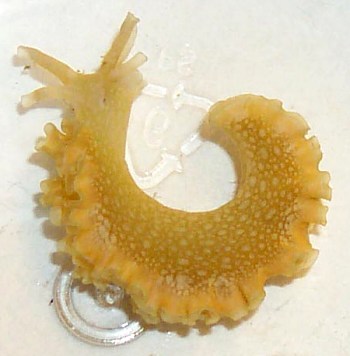
Dear Anna,
How is your work going? What an interesting animal. I don't know if it better to describe these rhinophores as 'paired' or bifid. They certainly remind me of the bifurcate rhinophores of the caliphyllids such as Cyerce nigricans and Polybranchia orientalis. Another addition to the Abnormalities List.
Best wishes,
Bill Rudman
Elysia crispata? in aquaria
April 1, 2002
From: Ash
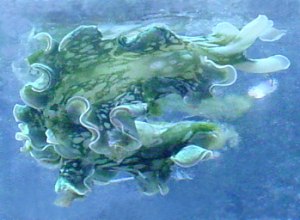
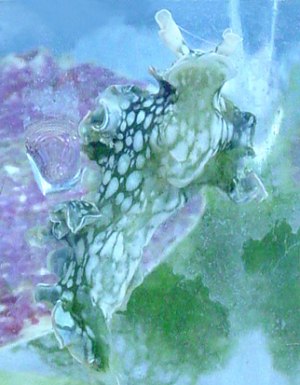
Note added 30 May 2006: This is Elysia clarki, a new species which was previously considered a colour form of E. crispata
Hi,
I just purchased this cute little fellow from my local fish shop. He was labelled as a "Lettuce Leaf Nudibranch", a term which is generally used for Elysia crispata. I know he's not a nudibranch, but I'm not absolutely positive he's a E. crispata. He doesn't have the characteristic "lettuce head" or "lettuce leaf" appearance that gives them their common name. Is he just an unusual variation of E. crispata?
Ash
veggieash@aol.com
Ash, 2002 (Apr 1) Elysia crispata? in aquaria. [Message in] Sea Slug Forum. Australian Museum, Sydney. Available from http://www.seaslugforum.net/find/6533Dear Ash,
It looks very like the photos of animals in messages from Anne DuPont and Jeff Zimmerman. It is quite variable in colour and in the degree of 'frilliness' along the edge of the parapodia. I am pretty sure its just a variation but I am sure someone will let us know if you have something else.
Best wishes,
Bill Rudman
Re: Baby slugs! - Elysia crispata
June 4, 2001
From: Jeff Zimmerman
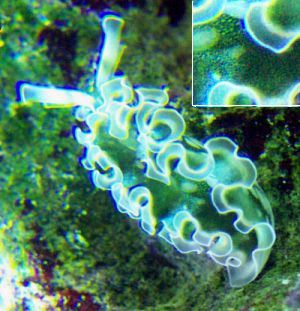
Note added 30 May 2006: This is Elysia clarki, a new species which was previously considered a colour form of E. crispata
I've got more pictures of the slugs as they are growing up and making families of their own. I estimate that the juvenile slugs in the pictures are the third generation of slugs in my tank. Pretty neat!
They seem to grow about 3/16 of an inch per month, to a maximum length of about 1 inch. The first set of slugs that I purchased were larger than that (1.5 to 2 inches), but I would guess that they probably had more food available to them. They seem to live about 3-6 months, with new slugs appearing every 2 months or so.
What I find really interesting is the "solar mode" that the slugs go into after cruising for algae for 5-8 hours or so. They "scrunch up" into an almost circular shape, with the area under the ruffles at maximum exposure to the light. It appears to me that they spend the first few hours of a light cycle looking for fresh food, and the last few hours in solar mode, recharging for the next day.
I'll post more as I observe more....
Jeff
jdzimme@qwest.net
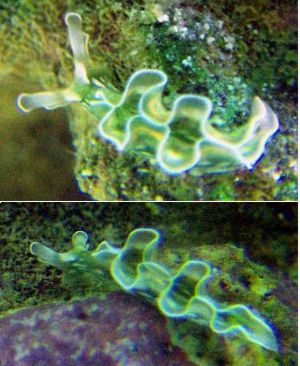
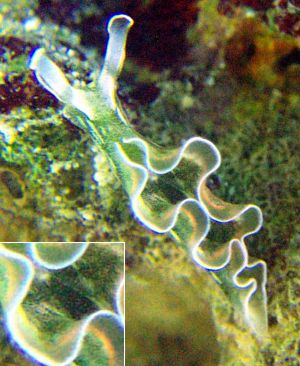
Dear Jeff,
Thanks for keeping us informed - definitely 'pretty neat'. I think this is a far more rewarding activity than slowly starving some poor nudibranch like Hypselodoris bullocki to death. I have added a couple of insets to your photos to show the green specks, which are the little clusters of chloroplasts that the slug steals from its plant food. To those of you who don't know how it uses these to help feed itself, have a look at the information at the top of this page.
I look forward to further observations.
Best wishes,
Bill Rudman
Re: Baby slugs! - Elysia crispata
March 22, 2001
From: Jeff Zimmerman
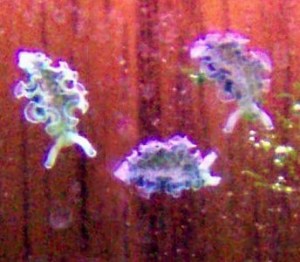
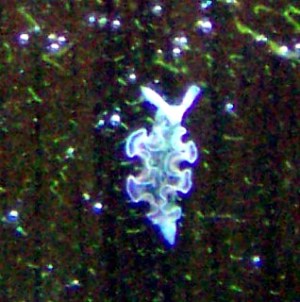
Note added 30 May 2006: This is Elysia clarki, a new species which was previously considered a colour form of E. crispata
I took some baby pictures of my new family. They aren't the greatest (no macro lens on my digital camera), but you get at least an idea of their size and shape. I'll post more when they become toddlers...
Jeff
jdzimme@qwest.net
Zimmerman, J., 2001 (Mar 22) Re: Baby slugs! - Elysia crispata. [Message in] Sea Slug Forum. Australian Museum, Sydney. Available from http://www.seaslugforum.net/find/4019Thanks Jeff,
Can you give us an idea of size? And it would be nice if you could keep a note on how fast they grow? Just a date and size every few weeks would be great.
Good luck with your babies - at least they won't keep you awake at night!
Bill Rudman
Baby slugs!
March 17, 2001
From: Jeff Zimmerman
Note added 30 May 2006: This is Elysia clarki, a new species which was previously considered a colour form of E. crispata
I've got the beginning of a reef aquarium that I purchased a cleanup crew for. I ended up with 4 lettuce slugs to help clean the green algae that always comes with a reef tank. I'm down to 2 of them after 3 months or so, and I'm not really sure what happens to them. They don't seem to die, they just disappear never to be seen again.
What I saw today just amazed me though. I was trying to figure out what this little green blotch was on the front of my tank. Of course, it was a tiny baby lettuce slug! I started looking, and there must be hundreds of the little critters crawling all over the place. They are all about the side of a printed zero (look on a check, that's about the right size), and have a variety of colors. Some are grayish, some are bright green, and a few are a combination of the two.
Here's my question: I know there will be a lot of these guys that don't survive. The circulation in my tank is pretty brisk, and I'm sure lots of them will get swept into the sump. I want to keep as many of these cute little guys around as possible though... any suggestions on what I need for them besides lots of light and lots of algae (both of which are no problem for me at the moment!)
Jeff
jdzimme@qwest.net
Zimmerman, J., 2001 (Mar 17) Baby slugs!. [Message in] Sea Slug Forum. Australian Museum, Sydney. Available from http://www.seaslugforum.net/find/3986Dear Jeff,
It's always great when you have a success without really trying! Your babies have survived swimming in your tank as microscopic veliger larvae without being sucked in to the sump, and are now crawling around and clearly growing. I would say as long as conditions stay the same you should end up with some healthy slugs. It is possible a few may get too curious and get sucked down the outlet pipe of your filter, but I can't imagine this will be a major problem.
Any chance of some baby photos?
Best wishes,
Bill Rudman
